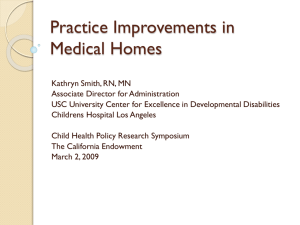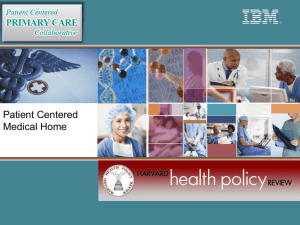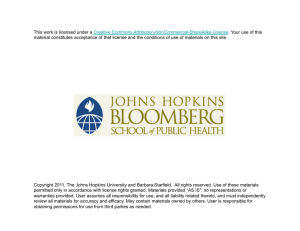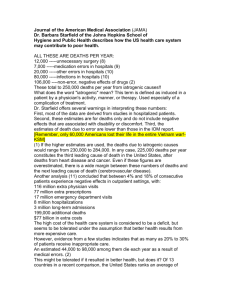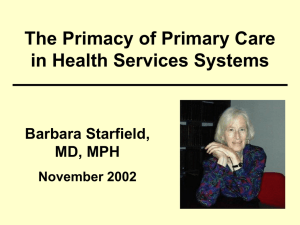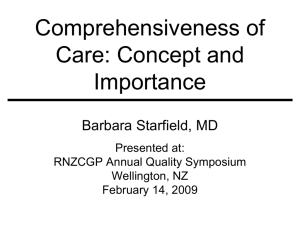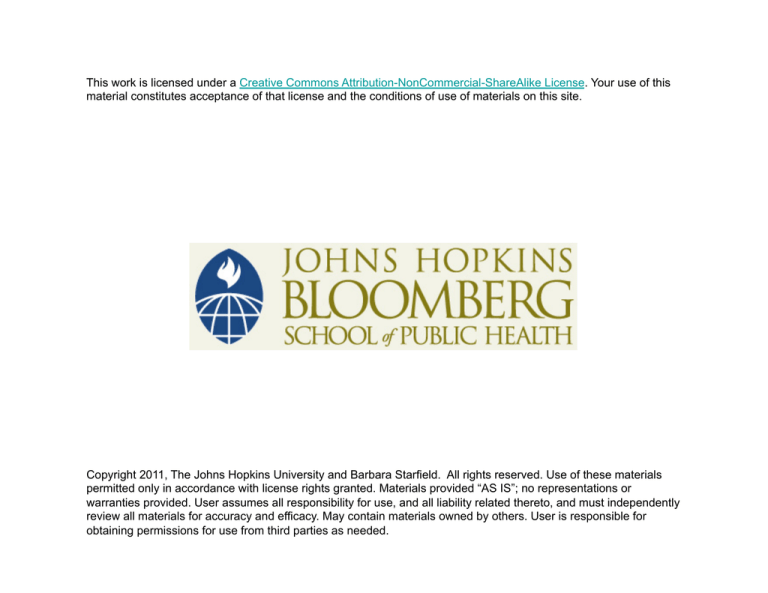
This work is licensed under a Creative Commons Attribution-NonCommercial-ShareAlike License. Your use of this
material constitutes acceptance of that license and the conditions of use of materials on this site.
Copyright 2011, The Johns Hopkins University and Barbara Starfield. All rights reserved. Use of these materials
permitted only in accordance with license rights granted. Materials provided “AS IS”; no representations or
warranties provided. User assumes all responsibility for use, and all liability related thereto, and must independently
review all materials for accuracy and efficacy. May contain materials owned by others. User is responsible for
obtaining permissions for use from third parties as needed.
Primary Care/Specialty Care
in the Era of Multimorbidity
Barbara Starfield, MD, MPH
19th WONCA World Conference of Family
Doctors (Cancun, Mexico, 2010)
ACG User Group (Tucson, AZ, 2010)
European Forum for Primary Care Keynote
Address (Pisa, Italy, 2010)
The Cost of Care
Dollar figures reflect all public and private spending on care, from doctor visits to hospital infrastructure. Data are
from 2007 or the most recent year available.
Starfield 01/10
IC 7251 n
Country* Clusters: Health Professional
Supply and Child Survival
Starfield 07/07
HS 6333 n
Primary Care and Specialist Physicians per 1000
Population, Selected OECD Countries, 2007
Country
Primary Care Specialists
Belgium
France
Germany
US
2.2
1.6
1.5
1.0
2.2
1.7
2.0
1.5
Australia
Canada
Sweden
1.4
1.0
0.6
1.4
1.1
2.6
Denmark
Finland
Netherlands
Spain
UK
0.8
0.7
0.5
0.9
0.7
1.2
1.6
1.0
1.2
1.8
Norway
Switzerland
New Zealand
0.8
0.5
0.8
2.2
2.8
0.8
OECD average
0.9
1.8
Source: OECD Health Data 2009
Starfield 03/10
WF 7318 n
Why Is Primary Care
Important?
Better health outcomes
Lower costs
Greater equity in health
Starfield 07/07
PC 6306 n
Primary health care oriented countries
• Have more equitable resource distributions
• Have health insurance or services that are
provided by the government
• Have little or no private health insurance
• Have no or low co-payments for health services
• Are rated as better by their populations
• Have primary care that includes a wider range
of services and is family oriented
• Have better health at lower costs
Sources: Starfield and Shi, Health Policy 2002; 60:201-18.
van Doorslaer et al, Health Econ 2004; 13:629-47.
Schoen et al, Health Aff 2005; W5: 509-25.
Starfield 11/05
IC 6311
Primary Care Strength and Premature
Mortality in 18 OECD Countries
Starfield 11/06
IC 5903 n
Many other studies done WITHIN countries,
both industrialized and developing, show that
areas with better primary care have better
health outcomes, including total mortality
rates, heart disease mortality rates, and
infant mortality, and earlier detection of
cancers such as colorectal cancer, breast
cancer, uterine/cervical cancer, and
melanoma. The opposite is the case for
higher specialist supply, which is associated
with worse outcomes.
Sources: Starfield et al, Milbank Q 2005;83:457-502.
Macinko et al, J Ambul Care Manage 2009;32:150-71.
Starfield 09/04
WC 6314
Strategy for Change in Health Systems
•
•
•
•
•
•
•
•
•
•
Achieving primary care
Avoiding an excess supply of specialists
Achieving equity in health
Addressing co- and multimorbidity
Responding to patients’ problems: using ICPC for
documenting and follow-up
Coordinating care
Avoiding adverse effects
Adapting payment mechanisms
Developing information systems that serve care
functions as well as clinical information
Primary care-public health link: role of primary care
in disease prevention
Starfield 11/06
HS 6457 n
Primary Care Scores by Data Source, PSF Clinics
Starfield 05/06
WC 6592 n
A study of individuals seen in a year in large health
care plans in the US found:
percent who saw a
specialist
average number of
different specialists seen
average number of visits
to specialists
total visits to both
primary care and
specialists
Source: Starfield et al, J Ambul Care Manage 2009;32:216-25.
elderly
95
non-elderly
69
4.0
1.7
8.8
3.3
11.5
5.9
Starfield 02/10
COMP 7284 n
A study of individuals (ages 20-79) seen
over two years in Ontario, Canada,
found:
percent who saw a specialist
median number of visits to
specialists
total visits to both primary
care and specialists
Source: Sibley et al, Med Care 2010;48:175-82.
53.2
1.0
7.0
Starfield 02/10
COMP 7322 n
The US has a significantly higher
proportion of people (compared with
Canada, France, Netherlands, New
Zealand, United Kingdom) who see two
or more specialists in a year – 27%,
and 38% among people with chronic
illness. Even these figures, obtained
from population surveys, understate the
heavy use of multiple physicians seen
in a year in the US.
Sources: Schoen et al, Health Aff 2007;26:W717-34.
Schoen et al, Health Aff 2009;28:w1-16.
Starfield 02/10
COMP 7283
Percent of Patients Reporting Any
Error by Number of Doctors Seen
in Past Two Years
Country
One doctor 4 or more doctors
Australia
12
37
Canada
15
40
Germany
14
31
New Zealand
14
35
UK
12
28
US
22
49
Source: Schoen et al, Health Affairs 2005; W5: 509-525.
Starfield 09/07
IC 6525 n
In the United States, half of all
outpatient visits to specialist physicians
are for the purpose of routine follow-up.
Does this seem like a prudent use of
expensive resources, when primary
care physicians could and should be
responsible for ongoing patient-focused
care over time?
Source: Valderas et al, Ann Fam Med 2009;7:104-11.
Starfield 08/09
SP 6528
In New Zealand, Australia, and the US,
an average of 1.4 problems (excluding
visits for prevention) were managed in
each visit. However, primary care
physicians in the US managed a narrower
range: 46 problems accounted for 75% of
problems managed in primary care, as
compared with 52 in Australia and 57 in
New Zealand.
Source: Bindman et al, BMJ 2007; 334:1261-6.
Starfield 01/07
COMP 6659 n
Comprehensiveness in primary
care is necessary in order to
avoid unnecessary referrals to
specialists, especially in people
with comorbidity.
Starfield 02/09
COMP 7090
30% of PCPs and 50% of specialists in
southwestern Ontario reported that scope
of primary care practice has increased in
the past two years. Physicians in solo
practice or hospital-based were more
likely to report an increase than those in
large groups. Family physicians were less
likely than general internists or
pediatricians to express concern about
increasing scope.
Source: St. Peter et al, The Scope of Care Expected of Primary Care
Physicians: Is It Greater Than It Should Be? Issue Brief 24. Center for Studying
Health System Change (http://www.hschange.com/CONTENT/58/58.pdf), 1999.
Starfield 04/10
COMP 7332
The Declining Comprehensiveness of
Primary Care
Starfield 03/10
COMP 7330
Comprehensiveness in Primary Care*
Wart removal
IUD insertion
IUD removal
Pap smear
Suturing lacerations
Hearing screening
Removal of cysts
Vision screening
Joint aspiration/injection
Foreign body removal (ear, nose)
Sprained ankle splint
Age-appropriate surveillance
Family planning
Immunizations
Smoking counseling
Remove ingrowing toenail
Home visits as needed
Behavior/MH counseling
Nutrition counseling
Electrocardiography
OTHERS?
Examination for dental status
*Unanimous agreement in a survey of family physician experts in ten countries (2008)
Starfield 03/08
COMP 6959 n
Comprehensiveness: Canadian Family
Physicians
Advanced procedural skills
Basic procedural skills
•
•
•
•
•
•
•
•
•
•
•
•
•
•
•
•
•
•
•
•
Sigmoidoscopy
Intensive care/resuscitation
Nerve blocks
Minor fractures
Chalazion
Tumour excision
Vasectomy
Varicose veins
Rhinoplasty
Fractures
Insertion of IUD
Biopsy
Cryotherapy
Electrocardiogram
Injection/aspiration of joint
Allerlgy/hyposensitization test
Excision of nail
Wound suture
Removal of foreign body
Incision, abscess, etc.
NOTE that British Columbia family physicians are more comprehensive than
their counterparts in other provinces.
Source: Canadian Institute for Health Information. The
Evolving Role of Canada's Fee-for-Service Family
Physicians, 1994-2003: Provincial Profiles. 2006.
Starfield 02/09
COMP 7095 n
Provincial Participation Rates of Canadian Feefor-Service Family Physicians in: Advanced and
Basic Procedural Skills
Source: National Physician Database, CIHI, as summarized in Canadian
Institute for Health Information, The Evolving Role of Canada's Fee-forService Family Physicians, 1994-2003: Provincial Profiles, 2006.
Starfield 02/09
COMP 7093 n
The Appropriate Management of
Multimorbidity in Primary Care
Starfield 04/10
CM 7334
Percentage of Patients Referred in a Year: US vs. UK
Starfield 04/08
CM 5871 n
Top 5 Predictors of Referrals, US
Collaborative Practice Network, 1997-99
All referrals
High comorbidity burden
Uncommon primary diagnosis
Moderate morbidity burden
Surgical diagnoses
Gatekeeping
Discretionary referrals†
Patient ages 0-17*
Nurse referrals permitted
Northeast region
Physician is an internist
Gatekeeping with capitation**
NOTE:
* No pediatricians included in study
** Specialists not in capitation plan
†Common conditions + high certainty for diagnosis and treatment + low urgency + only cognitive
assistance requested. Constituted 17% of referrals.
Source: Forrest et al, Med Decis Making 2006;26:76-85.
Starfield 10/05
RC 6497 n
The more common the condition in primary care
visits, the less the likelihood of referral, even after
controlling for a variety of patient and disease
characteristics.
When comorbidity is very high, referral is more
likely, even in the presence of common problems.
IS THIS APPROPRIATE? IS SEEING A
MULTIPLICITY OF SPECIALISTS THE
APPROPRIATE STRATEGY FOR PEOPLE WITH
HIGH COMORBIDITY?
Source: Forrest & Reid, J Fam Pract 2001;50:427-32.
Starfield 03/10
RC 7068
Percent Distribution by Degree of Comorbidity for
Selected Disease Groups, Non-elderly Population
Morbidity Burden Level (ACGs)
Disease Group
Low
Mid
High
Total population
69.0*
27.5
4.0
Asthma
24.0
63.8
12.2
Hypertension
20.7
65.4
13.9
Ischemic heart disease
3.9
49.0
47.1
Congestive heart failure
2.6
35.1
62.3
Disorders of lipoid metabolism
17.6
69.9
12.5
Diabetes mellitus
13.9
63.2
22.9
Osteoporosis
11.1
50.0
38.9
Thrombophlebitis
12.2
53.8
33.9
8.1
66.3
25.6
Depression, anxiety, neuroses
*About 20% have no comorbidity.
Source: ACG Manual
Starfield 12/04
CM 5690 n
Comorbidity Prevalence
1. The percentage of Medicare beneficiaries with 5+
treated conditions increased from 31 to 40 to 50 in 1987,
1997, 2002.
2. The age-adjusted prevalence increased for
• Hyperlipidemia: 2.6 to 10.7 to 22.2
• Osteoporosis: 2.2 to 5.2 to 10.3
• Mental disorders: 7.9 to 13.1 to 19.0
• Heart disease: 27.0 to 26.1 to 27.8
3. The percentage of those with 5+ treated conditions who
reported being in excellent or good health increased
from 10% to 30% between 1987 and 2002.
MESSAGE: “Discretionary diagnoses” are increasing in
prevalence, particularly those associated with new
pharmaceuticals. How much of this is appropriate?
Source: Thorpe & Howard, Health Aff 2006; 25:W378-W388.
Starfield 08/06
CM 6600 n
Differences in Mean Number of Chronic
Conditions among Enrollees Age 65+ Reporting
Congestive Heart Failure, by Race/Ethnicity,
Income, and Education: 1998
Source: Bierman, Health Care Financ Rev 2004; 25:105-17.
Starfield 11/06
CM 6337 n
Comorbidity, Inpatient Hospitalization,
Avoidable Events, and Costs*
Source: Wolff et al, Arch Intern
Med 2002; 162:2269-76.
*ages 65+, chronic conditions only
Starfield 11/06
CM 5686 n
Controlled for morbidity burden*:
The more DIFFERENT generalists seen: higher
total costs, medical costs, diagnostic tests and
interventions.
The more different generalists seen, the more
DIFFERENT specialists seen among patients with
high morbidity burdens. The effect is independent
of the number of generalist visits. That is, the
benefits of primary care are greatest for people
with the greatest burden of illness.
*Using the Johns Hopkins Adjusted Clinical Groups (ACGs)
Source: Starfield et al, J Ambul Care Manage 2009;32:216-25.
Starfield 02/10
LONG 7288 n
Resource Use, Controlling for
Morbidity Burden*
The more DIFFERENT specialists
seen, the higher total costs, medical
costs, diagnostic tests and
interventions, and types of medication.
*Using the Johns Hopkins Adjusted Clinical Groups (ACGs)
Source: Starfield et al, J Ambul Care Manage 2009;32:216-25.
Starfield 04/10
SP 7333
Summary of Predictability of Year 1 Characteristics,
with Regard to Subsequent Year’s (3 or 5) Costs
Rank for
relative risk
Underpredictive*
Overpredictive
1+ hospitalizations
5
90%
40%
8+ morbidity types (ADGs)
2
64%
55%
4+ major morbidity types (ADGs)
1
75%
30%
Top 10th percentile for costs
(ACGs)
4
96%
70%
10+ specific diagnoses
3
82%
40%
*Underpredictive:% of those with subsequent high cost who did not have
the characteristic
Overpredictive: % with characteristic who are not subsequently high cost
Source: ACG team, JHSPH
Starfield 09/00
CM 5577 n
Influences* on Use of Family Physicians and
Specialists, Ontario, Canada, 2000-1
Primary care visits
Type of influence
Mean
Specialty visits
One or
One or
Median more Mean Median more
# different types of
morbidity (ADGs)
1
1
1
1
1
1
Morbidity burden
(ACGs)
2
2
2
2
2
2
Self-rated health
3
3
5
3
-
5
Disability
4
4
4
4
4
4
# chronic conditions**
5
5
3
-
-
-
Age 65 or more
-
-
-
5
3
3
*top five, in order of importance
**from a list of 24, including “other longstanding conditions”
Calculated from Table 2 in Sibley et al, Med Care 2010;48:175-82.
Starfield 02/10
CM 7317 n
Expected Resource Use (Relative to Adult
Population Average) by Level of
Comorbidity, British Columbia, 1997-98
Acute conditions
only
Chronic condition
High impact chronic
condition
None
0.1
Low
0.4
Medium
1.2
High
3.3
Very
High
9.5
0.2
0.2
0.5
0.5
1.3
1.3
3.5
3.6
9.8
9.9
Thus, it is comorbidity, rather than presence or impact of
chronic conditions, that generates resource use.
Source: Broemeling et al. Chronic Conditions and Co-morbidity among Residents
of British Columbia. Vancouver, BC: University of British Columbia, 2005.
Starfield 09/07
CM 6622 n
Results: Case-mix by SES - ACG
Starfield 03/10
CM 7327 n
Results: Capitation Fee and
Morbidity by SES
Starfield 03/10
CM 7329 n
Methods (I)
• Representative sample of 66,500 adults
(age 18 or older) enrolled in Clalit Health
Services (Israel’s largest health plan)
during 2006
• Data from diagnoses registered in
electronic medical records during all
encounters (primary, specialty, and
hospital), and health care use registered in
Clalit’s administrative data warehouse
Source: Shadmi et al, Morbidity pattern and resource use
in adults with multiple chronic conditions, presented 2010.
Starfield 04/10
CMOS 7335
Methods (II)
• Morbidity spectrum: ADGs were used to classify
the population into 3 groups:
– Low (0-2 ADGs)
– Medium (3-5 ADGs)
– High (>=6 ADGs)
• Clalit’s Chronic Disease Registry (CCDR):
– ~180 diseases. Based on data from diagnoses, lab
tests, Rx
• Charlson Index: – Based on data from the CCDR
– Range 0-19
Source: Shadmi et al, Morbidity pattern and resource use
in adults with multiple chronic conditions, presented 2010.
Starfield 04/10
CMOS 7336
Methods (III)
Resource use:
– Costs: total, hospital, ambulatory
(standardized price X unit)
– Specialist visits
– Primary care physician visits
– Resource use ratio: mean total cost per
morbidity group divided by the average total
cost
Source: Shadmi et al, Morbidity pattern and resource use
in adults with multiple chronic conditions, presented 2010.
Starfield 04/10
CMOS 7337
Resource Use in Adults with No
Chronic Conditions
• 30% of persons with no chronic conditions have an
average resource use ratio higher than some of the
people (5%) with 5 or more chronic conditions
• This is, resource use in populations is not highly related to
having a chronic condition, in the absence of
consideration of other conditions
Source: Shadmi et al, 2009; Morbidity pattern and resource use
in adults with multiple chronic conditions, presented 2010.
Starfield 04/10
CMOS 7338
Resource Use by Spectrum of Morbidity: Adults
with No Chronic Conditions (N=28,700)
8000
25
Total costs
Hospital costs
Specialist visits
Primary care visits
Ambulatory costs
20
6000
5000
15
4000
10
3000
2000
Average Number of Visits
Standardized Costs
7000
5
1000
0
0
1
2
3
4
5
6
7
8
9
10
11
12+
Number of ADGs
Starfield 04/10
CMOS 7339
Resource Use in Adults with
Chronic Conditions
• Some people with as many as 6 chronic conditions have
less than average resource use
• Prevalent conditions in persons with 6 chronic diseases
and below average resource use:
– 80% hypertension
– 71% hyperlipidemia
– 42% diabetes
– 30% osteoperosis
Source: Shadmi et al, 2009; Morbidity pattern and resource use in
adults with multiple chronic conditions, presented 2010.
Starfield 04/10
CMOS 7340
Resource Use by Spectrum of Morbidity: Persons
with 3 Chronic Conditions (N=4,900)
14000
30
Hospital costs
Ambulatory costs
Specialist visits
Primary care visits
25
10000
20
8000
15
6000
10
4000
Average Number of Visits
Standardized Costs
12000
Total costs
5
2000
0
0
1
2
3
4
5
6
7
8
9
10
11
12+
Number of ADGs
Starfield 04/10
CMOS 7341
Morbidity Spectrum Explains
Health Care Resource Use (R2)
Age, sex
Chronic condition count,
age, sex
Charlson, age, sex
ADG, age sex
Total
cost*
12%
20%
Hospital
costs*
6%
9%
22%
42%
12%
27%
*Total costs: Hospital, ambulatory and Rx costs trimmed at 3 standard deviations above the mean.
Source: Shadmi et al, Morbidity pattern and resource use
in adults with multiple chronic conditions, presented 2010.
Starfield 04/10
CMOS 7342
A wide variety of studies indicates that it is not
the presence of chronic conditions, or even the
number of chronic conditions that contributes to
high costs. Rather, it is the extent of different
types of diagnoses and the pattern of the coexisting types of diagnoses that exerts the
greatest influence on resource use and, hence,
costs of care, as well as being a major
challenge for the care of patients in health
systems that are focused primarily on individual
diagnoses and the quality of care for individual
conditions as if they existed alone.
Starfield 06/10
CM 7372
Chronic Conditions and Use of Resources
Implications for care management:
– Care management based on selection of patients based
on chronic disease counts (e.g., persons with 4 or more
chronic conditions) will include many “false positives” (i.e.,
persons with low morbidity burden and low associated
resource use) and will miss many who could benefit from
such interventions.
• Implications for research:
– Adjustment for morbidity based on chronic condition
counts or the Charlson score fails to capture the morbidity
burden of 40-60% of the population.
– Adjustments using chronic condition counts or the
Charlson score explain only half or less of the variance
explained by ADGs (morbidity spectrum).
Source: Shadmi et al, Morbidity pattern and resource use
in adults with multiple chronic conditions, presented 2010.
Starfield 04/10
CMOS 7343
Applications of Morbidity-Mix Adjustment
1.
2.
3.
Physician/group oriented
• Characterizing and explaining variability in resource
use
• Understanding the use of and referrals to specialty
care
• Controlling for comorbidity
• Capitation payments
• Refining payment for performance
Patient/population oriented
• Identifying need for tailored management in population
subgroups
• Surveillance for changes in morbidity patterns
• Targeting disparities reduction
Improve understanding of genesis of vulnerability to multiple
illnesses
Starfield 03/06
CM 6545
Choice of Comorbidity Measure
Depends on the Purpose
•
•
•
•
•
population morbidity assessments
prediction of death
prediction of costs
prediction of need for primary care services
prediction of use of specialty services
The US is focused heavily on costs of care. Therefore, it
focuses in measures for predicting costs and predicting
deaths.
A primary care-oriented health system would prefer a
measure of predicting need for and use of specialty
services.
Starfield 04/07
CM 6712
Multimorbidity and Use of Primary
and Secondary Care Services
• Morbidity and comorbidity (and hence
multimorbidity) are increasing.
• Specialist use is increasing, especially for
routine care.
• The appropriate role of specialists in the
care of patients with different health levels
and health needs is unknown.
Starfield 03/10
SP 7320
We know that
1. Inappropriate referrals to specialists lead to
greater frequency of tests and more false positive
results than appropriate referrals to specialists.
2. Inappropriate referrals to specialists lead to poorer
outcomes than appropriate referrals.
3. The socially advantaged have higher rates of visits
to specialists than the socially disadvantaged.
4. The more the subspecialist training of primary
care MDs, the more the referrals.
A MAJOR ROLE OF PRIMARY CARE IS TO ASSURE
THAT SPECIALTY CARE IS MORE APPROPRIATE
AND, THEREFORE, MORE EFFECTIVE.
Sources: Starfield et al, Health Aff 2005; W5:97-107. van Doorslaer et al, Health Econ
2004; 13:629-47. Starfield B, Gervas J. Comprehensiveness v special interests: Family
medicine should encourage its clinicians to subspecialize: Negative. In: Kennealy T,
Buetow S, ed. Ideological Debates in Family Medicine. Nova Publishing, 2007.
Starfield 08/05
SP 6322
What is the right number of
specialists?
What do specialists do?
What do specialists contribute
to population health?
Starfield 01/06
SP 6527
What We Do Not Know
The contribution of specialists to
• Unnecessary care (due to overestimation
of the likelihood of disease)
• Potentially unjustified care (due to
inappropriateness of guidelines when
there is comorbidity)
• Adverse effects (from the cascade effects
of excessive diagnostic tests)
Starfield 11/05
SP 6503
What We Need to Know
• What specialists contribute to population
health
• The optimum ratio of specialists to population
• The functions of specialty care and the
appropriate balance among the functions
• The appropriate division of effort between
primary care and specialty care
• The point at which an increasing supply of
specialists becomes dysfunctional
Starfield 11/05
SP 6504
Aspects of Care That Distinguish
Conventional Health Care from PeopleCentred Primary Care
Source: World Health Organization. The World Health Report 2008:
Primary Health Care – Now More than Ever. Geneva, Switzerland, 2008.
Starfield 05/09
PC 7123 n
Conclusion
Virchow said that medicine is a social
science and politics is medicine on a grand
scale.
Along with improved social and
environmental conditions as a result of
public health and social policies, primary
care is an important aspect of policy to
achieve effectiveness, efficacy, and equity
in health services.
Starfield 03/05
PC 6326
Conclusion
Although sociodemographic factors
undoubtedly influence health, a primary
care oriented health system is a highly
relevant policy strategy because its
effect is clear and relatively rapid,
particularly concerning prevention of
the progression of illness and effects of
injury, especially at younger ages.
Starfield 11/05
HS 6310
Strategy for Change in Health Systems
•
•
•
•
•
•
•
•
•
•
Achieving primary care
Avoiding an excess supply of specialists
Achieving equity in health
Addressing co- and multimorbidity
Responding to patients’ problems: using ICPC for
documenting and follow-up
Coordinating care
Avoiding adverse effects
Adapting payment mechanisms
Developing information systems that serve care
functions as well as clinical information
Primary care-public health link: role of primary care
in disease prevention
Starfield 11/06
HS 6457 n


